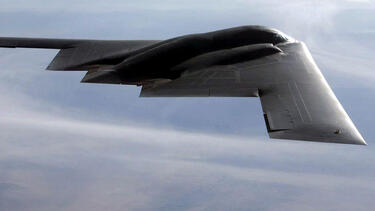Women Leaders Ascend in the Aerospace and Defense Industry
When Kathy Warden was named CEO of Northrop Grumman this week, she became the third woman CEO among the top five aerospace and defense contractors. Yale SOM’s Jeffrey Sonnenfeld writes that this welcome trend has an echo in the early history of the industry.

The Northrop Grumman B-2 Spirit. Photo: U.S. Air Force/Wikimedia.
This article was originally published in Chief Executive.
Kathy Warden’s ascension to the CEO position at Northrop Grumman is as substantive as it is symbolic. With a record number of women running for public office, there has ironically been a 25% decline this past year in the number of women CEOs at Fortune 500 companies. That number slipped from 32 last year to 24 this year.
But while women are the chief executives of just 4.8% of major firms, three of the top five aerospace and defense contractor companies are now run by women. Marillyn Hewson leads Lockheed Martin, the world’s largest defense contractor. Phebe Novakovic, who served in the Pentagon and the CIA, is CEO and chairwoman of General Dynamics. And now Warden is CEO at Northrop Grumman.
This is especially noteworthy given expectations for a macho-heavy industry culture and its past. Looking back at the industry’s founding, there were the swashbuckling daredevil aviation inventors with the past century’s bro-culture. Just a decade or so after the Wright Brothers, there was William Boeing, Alan Lockheed, Glenn Martin, Lee Grumman, Jack Northrop, Glenn Curtiss, and Igor Sikorsky. These tinkerers, inventors, and engineers were the pioneers of aviation.
But there was also Olive Beech, Beechcraft aviation, a pioneer in female aviation. She took over the leadership of the company in 1940 and ran it until she passed over the presidency to her nephew in 1968, staying on as chairman until 1982.
In a 1982 interview for my book The Hero’s Farewell, Beech told me that advancing opportunity for other women in the industry was a special source of pride. To spark sales of some new model planes, she sponsored women pilots going back to 1936 in high-profile successful transcontinental contests against some of the best male pilots.
While her efforts didn’t prove to be sustainable, there has been a slow return to women in aerospace. Aviation Week reported that women made up 24% of the workforce in the aerospace and defense industry last year. Consistent with that, nearly a quarter of executive-level positions were held by women last year. There is no doubt that Warden, Hewson, and Novakovic’s places in their respective companies, as well as Leanne Caret, who has run Boeing’s defense, space, and security division since 2016, can tilt the scales even further.
Their roles are not ornamental or driven by political correctness, but the culmination of a terrific performance in challenging mainstream career track postings. Hewson, for example, served as Lockheed’s president and chief operating officer, and its executive vice president of electrical systems business area, president of systems integration, executive vice president of global sustainment, president and general manager of Kelly Aviation Center, L.P. and the president of logistics services. The stock has more the tripled in her five years off leadership. She was recently named the Chief Executive CEO of the Year.
Novakovic’s father was a penniless teenage Serbian immigrant who became an intelligence officer in the U.S. Air Force. He encouraged her to launch her own career with the CIA, where she was an operations officer. She later worked for the Office of Management and Budget and then the Pentagon. She joined General Dynamics in 2001 as vice president of strategic planning, later becoming executive vice president for the company’s marine systems. Last year’s $5 billion order to design the next version of the U.S. Navy’s ballistic-missile submarine was a major triumph under her leadership. Since she became CEO in 2013, the company’s stock has seen a 100% growth.
Before being named Northrop Grumann’s new leader, Warden previously served as vice president and general manager of the company’s cybersecurity business, president of its former information systems sector, and president of its mission systems sector. Like Hewson and Novakovic, she’s an experienced aerospace business leader on a soaring path. Northrop Grumman is in good hands.
Hopefully this flight path will continue, but already we know Olive Beech would be very proud of where’s it gone.